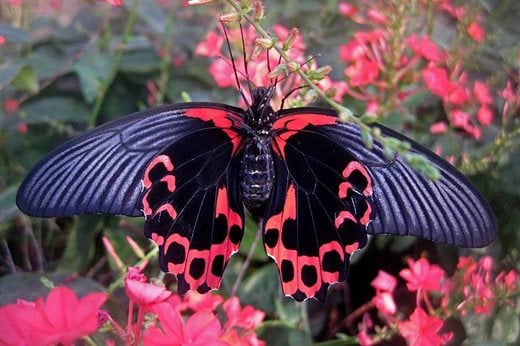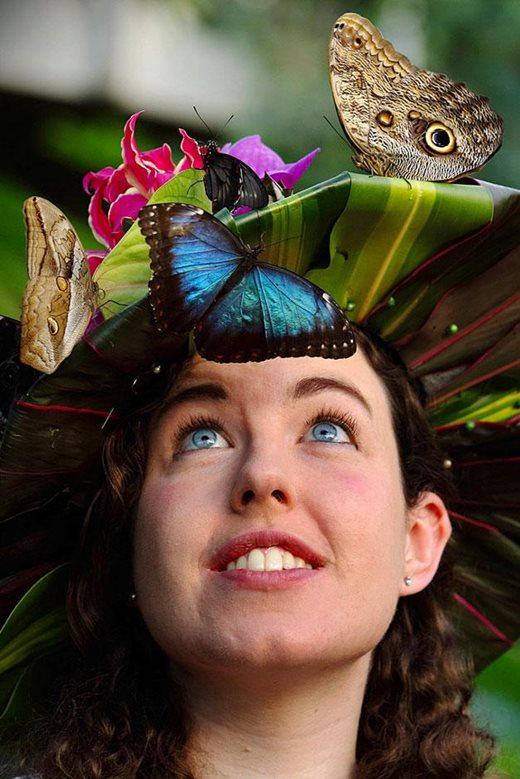Exotic butterflies are a-fluttering in the Wisley Glasshouse - but not for long! This weekend is your last chance to see them

Here in the lab we absolutely love the
Butterflies in the Glasshouse exhibit, and any winter blues can easily be banished by a lunchtime walk through our very own tropical paradise!
I hear many visitors exclaim not just about the beauty of the butterflies but also their exoticness and other worldliness. Wandering around Wisley in summer, however, and I wonder whether these butterflies would actually feel so out of place. The butterflies, all of which come from tropical climes, would not survive the UK weather long – even in the summer – but
we take for granted many plants that our tropical butterflies would recognise as a touch of home.
The caterpillars of most butterflies will only thrive on one, or several closely related, species of plants. This means that female butterflies are very careful where they lay their eggs in order to give their caterpillars the best start in life. Butterflies have receptors in their feet.
When deciding where to lay her eggs, a female butterflies will first stroke the leaves of plants with her forelegs. By doing this she can not only identify the plant but also other attributes, which tell her how good that particular plant will be as food for her caterpillars.
Camouflage and subterfuge
 The larvae of both the postman butterfly (Heliconius melpomene) and the zebra longwing (Heliconius charithona) feed on various species of passionflower (Passiflora spp.). These plants can often be seen thriving in sunny, sheltered garden spots in mild regions of the UK and we have a particularly beautiful specimen that grows on the wall of the laboratory at Wisley. The foliage of passiflora plants are toxic so as to deter caterpillar feeding but that doesn’t stop postman and zebra longwing caterpillars. They can not only eat the toxic leaves – giving them access to a food source free from competition – but they actually store up the toxins within their bodies to make themselves distasteful to birds.
The larvae of both the postman butterfly (Heliconius melpomene) and the zebra longwing (Heliconius charithona) feed on various species of passionflower (Passiflora spp.). These plants can often be seen thriving in sunny, sheltered garden spots in mild regions of the UK and we have a particularly beautiful specimen that grows on the wall of the laboratory at Wisley. The foliage of passiflora plants are toxic so as to deter caterpillar feeding but that doesn’t stop postman and zebra longwing caterpillars. They can not only eat the toxic leaves – giving them access to a food source free from competition – but they actually store up the toxins within their bodies to make themselves distasteful to birds.
The passionflowers, not to be outdone, have another trick; to dissuade females from laying eggs in the first place, some species produce yellow sugar deposits on their leaves which mimic the eggs of the butterflies hoping an egg-laying female will see these and pass on to lay on another, less crowded, leaf.
The citrus swallowtails (Papilio demodocus and P. demoleus) lay their eggs on lemon trees – popular conservatory plants. These caterpillars mimic bird droppings when they are young, but as they grow older they become green with eyespots and, when threatened, complete their snake disguise by extending a forked red ‘tongue’. This ‘tongue’ is actually a gland that produces a citrus smell to deter predators such as ants and small spiders.
The caterpillars of the pale owl butterfly (Caligo telamonious memnon) feed on banana plants and, although outside here at Wisley ours are currently wrapped up warm for the winter, they do lay eggs on the plants in the tropical zone of the glasshouse. These caterpillars can grow very quickly, increasing in size by 1,000-fold or even more in just a few weeks. This means that they must eat a lot of banana leaves, and in Central and South America they are sometimes considered pests of banana plantations. In the glasshouse at Wisley where caterpillars are found they must therefore be carefully removed and sent to another butterfly house to stop our poor banana plants being stripped!
So, while our climate means we cannot see butterflies like those in the Wisley Glasshouse outside in the UK, we can enjoy a touch of their homeland from the plants we grow. In the meantime, please come and visit our little piece of paradise at RHS Wisley – Butterflies in the Glasshouse runs until Sunday March 6.
Related links
Find out more about Butterflies in the Glasshouse
Encouraging UK butterflies

